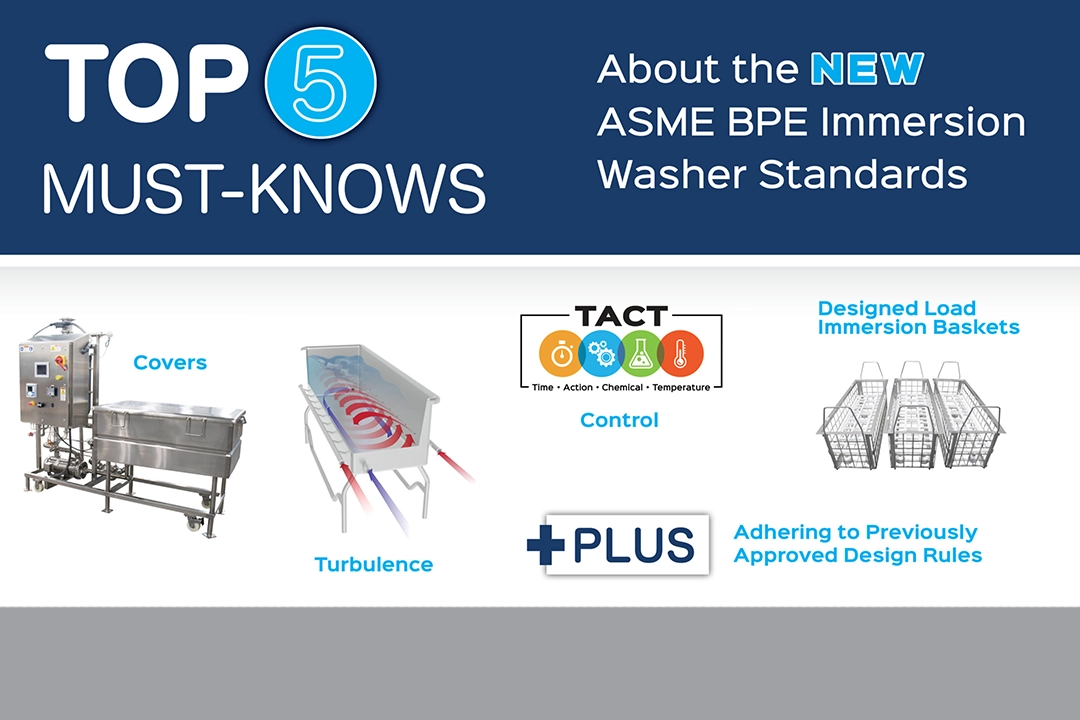Guidance to meet pharmaceutical manufacturing regulatory standards is everchanging, as is highlighted in the recent 2019 ASME BPE System Design Standards for Immersion Washers.
Two Sani-Matic experts, Solo Yang, sales engineer and BPE contributing member, and Pete Barrie, senior product manager and BPE Systems Design committee member, provide a brief overview of ASME BPE, how standards come to be, and the five must-knows about the recent BPE System Design Standards for Immersion Washers.
What is ASME BPE?
In 1988, The American Society of Mechanical Engineers (ASME) realized the need for biopharmaceutical processing equipment and components standards. On May 20, 1997, after eight years of work by an ASME group (which became the Bioprocessing Equipment (BPE) standards group), the first edition of the BPE Standard was approved as an American National Standard.
“Unlike the FDA’s Good Manufacturing Processes (GMPs), which primarily speak to the manufacturing of the pharmaceutical products themselves, the BPE System Design Standards provide critical hygienic design guidance for the equipment used in biopharmaceutical processing,” Barrie explained.
Twenty-two years after the first approved standards, BPE released the ASME BPE-2019 standards, which features design standards for Immersion Washers.
How are BPE System Design Standards created and approved?
Barrie emphasized that all design standards must be meaningful to the industry to achieve the group’s intent. To ensure meaningful standards, BPE members include diverse and talented industry experts from three main groups:
- Equipment and Component Manufacturers,
- Architectural and Engineering firms and validation groups, and
- End-users.
Yang added, “How the group determines what components and systems require hygienic guidance depends on what is happening in the industry. Ideas can come from BPE members or change requests submitted to BPE. In the case of the Immersion Washer standard, BPE members wanted to ensure pharmaceutical manufacturers considered hygienic design with the commonly used equipment.”
“Once a topic is determined, creating and approving the design standard can be a long process,” explained Yang.
Barrie elaborated, “The Immersion Washers standard took around two years. During that time, a task group with four to six members met regularly. These meetings included monthly conference calls, and in-person BPE committee meetings three times a year. After the task group’s work, the design standard went to the System Design (SD) subcommittee for review, comment, and approval. It then moved to the main committee for final approval.”
The Top 5 Must-Knows of the BPE System Design Standards for Immersion Washers
Barrie and Yang discussed the top five must-knows regarding the recent BPE System Design Standards for Immersion Parts Washers. (SD-6.5 Immersion Washers)
- Turbulence is King.
The washer’s zone design (side jets and/or end jets) is critical to achieving the necessary turbulence (or cleaning action) for a validatable clean. (SD-6.5.4.1 Zone Design)
“The standard requires consistent action (flow and pressure of turbulence) across all cleaning cycle phases (pre-rinse, wash, and final rinse) to ensure all parts are thoroughly cleaned and rinsed,” explained Barrie. “And, to determine which zone design can accomplish that requires a complete review of the process parts the manufacturer cleans,” he added.
Section SD-6.5.4.1 also states the zone design shall follow other BPE existing system design requirements, such as eliminating dead legs, and minimizing L/D.
Barrie noted standards stating “shall” are to be taken as a requirement, whereas items listed as “should” are strongly encouraged.
- Part Holding or Part Placement Requirements. (SD-6.5.4.3 Baskets and Racks)
The Cabinet Washer System Design Standard (SD-6.1 Cabinet Washers) requires repeatable process part holding. The Immersion Washer standard describes two categories for part placement:
- Designed Load Immersion Baskets/Racks – These basket designs clean geometrically complex parts, and the configured orientation provides repeatable cleaning results. The Designed Load Baskets/Racks shall be drainable.
“The Designed Load Immersion Baskets may be subject to verification, and riboflavin Flow Coverage testing can apply,” explained Yang. “Riboflavin testing can confirm recessed areas are clean with configured part orientation and a drainable design,” he added. (SD-6.5.7.1 Flow Coverage)
- General Load Immersion Baskets/Racks – These are simple baskets designed to wash geometrically simple parts (gaskets, clamp tools, etc.) when repeatable orientation is not critical.
- Covers Should Be Used.
Barrie detailed that both sealed (e.g., gaskets or O-ring) and non-sealed covers are permitted to protect operators from exposure to solutions. Covers also help control humidity levels in production rooms. Sealed covers shall maintain a design with the intent to prevent solution leakage during a wash cycle. Non-sealed covers should minimize leakage. (SD-6.5.4.2 Tank and Cover Openings)
- Time/Action/Chemical/Temperature (TACT) requirements.
“At Sani-Matic, we consider TACT for every hygienic process cleaning solution we develop,” Barrie said. He further explained, section SD-6.5.3 highlights that Immersion Parts Washers need to control Time, pressure/flow (Action), Chemical addition/concentration, control/monitor solution Temperature, and provide analytical verification of final rinse water quality (e.g., conductivity).
- The Immersion Washer design Shall include the equipment and components design rules outlined in BPE’s previously determined hygienic design guidance.
“Pre-determined hygienic design standards for pumps and piping, etc. automatically apply to all new design standards,” stated Yang.
Contact our in-house BPE System Design Standards experts for information regarding the recent Immersion Washer standards, Cabinet Washer standards, CIP standards, or other BPE topics.

